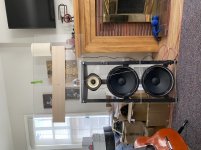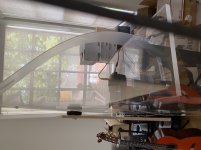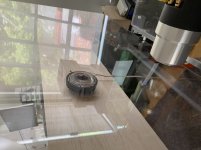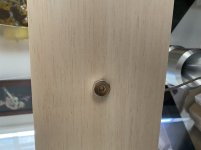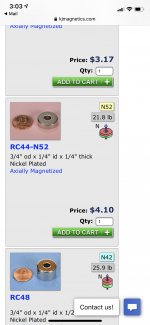What you have there looks like what I bought at HomeDepot: https://www.homedepot.com/p/3-4-in-...-Insulation-Sheathing-6-Pack-150705/202090272
Its low quality eps foam and comes in sheets 14.25" x 48" x .75" (a really nice pleasing size for a standup panel). It comes in 6 sheet panels for like $8 the package, so really cheap and easy to experiment with. It is quite light, the sheet if I'm not mistaken weighs only about 180 grams, quite light but its compressive strength is not bad and bendability is good. The surface texture is just as you show, a bit rough but not holey. It doesn't really have a "skin" to it so I would not try to sand it, nor do I skin it with glue mix. I mount exciters to it by providing a flatter more rigid surface. Basically I make a 50/50 white glue mixture and then make a small 1-2" pad on the panel that just fits the exciter position. I use several coats of the glue as it will soak into the foam. 4-5 coats seem to provide a nice firm, flat pad for the exciter. And if needed you can very lightly sand the glue pad to make it perfectly flat for a good exciter connection. (I've not found that necessary with enough coats of the glue.)
Unfortunately I havent had time to actually wire it all up yet so I can't say how it sounds but I'm hopeful. BTW don't try to solder leads on the exciter while its mounted on the foam...you will melt the foam and form holes...ask me how I know (sigh).
The eps is easy to cut though does leave pretty rough edges due to the foam beads If you want to try trapizoidal or trapezium shapes. A hot wire would work better I assume. At .75" thick, its more than I would like but we'll see how it works...
geo
Its low quality eps foam and comes in sheets 14.25" x 48" x .75" (a really nice pleasing size for a standup panel). It comes in 6 sheet panels for like $8 the package, so really cheap and easy to experiment with. It is quite light, the sheet if I'm not mistaken weighs only about 180 grams, quite light but its compressive strength is not bad and bendability is good. The surface texture is just as you show, a bit rough but not holey. It doesn't really have a "skin" to it so I would not try to sand it, nor do I skin it with glue mix. I mount exciters to it by providing a flatter more rigid surface. Basically I make a 50/50 white glue mixture and then make a small 1-2" pad on the panel that just fits the exciter position. I use several coats of the glue as it will soak into the foam. 4-5 coats seem to provide a nice firm, flat pad for the exciter. And if needed you can very lightly sand the glue pad to make it perfectly flat for a good exciter connection. (I've not found that necessary with enough coats of the glue.)
Unfortunately I havent had time to actually wire it all up yet so I can't say how it sounds but I'm hopeful. BTW don't try to solder leads on the exciter while its mounted on the foam...you will melt the foam and form holes...ask me how I know (sigh).
The eps is easy to cut though does leave pretty rough edges due to the foam beads If you want to try trapizoidal or trapezium shapes. A hot wire would work better I assume. At .75" thick, its more than I would like but we'll see how it works...
geo
As an Aside to above, I just found this: Dayton Audio DAEX25Q-4 Quad Feet 25mm Exciter 20W 4 Ohm
Look at the customer photos and the the little article in the comments section. He used these same EPS panels and seem quite happy with the sound, though they do look horrible the way he painted them and he used a single 20W exciter, but his stand method is pretty simple and cheap. Just food for thought...
Look at the customer photos and the the little article in the comments section. He used these same EPS panels and seem quite happy with the sound, though they do look horrible the way he painted them and he used a single 20W exciter, but his stand method is pretty simple and cheap. Just food for thought...
Last edited:
Spedge - it sounds more hollow like when I scratch with my nails. It’s exactly the ones geosand referenced.
Geosand- Appreciate the advice, looking forward to your results. Im pretty hopeful with the exciters I got, I do like the stands from the reviewer you referenced. I plan to shorten mine to around 3’ and round the corners, but make one side a little shorter than the other. I’m happy to see others using the same panel. I was afraid it was too cheap or too narrow.
Geosand- Appreciate the advice, looking forward to your results. Im pretty hopeful with the exciters I got, I do like the stands from the reviewer you referenced. I plan to shorten mine to around 3’ and round the corners, but make one side a little shorter than the other. I’m happy to see others using the same panel. I was afraid it was too cheap or too narrow.
For those of us using diluted PVA glue for treating XPS/EPS, I found this experiment interesting. Great method and analysis of the hardness of various glues. Looks like Titebond All Purpose is a winner for that type. Elmer's and another Titebond are not as hard and have a lot of range. Am I correct in thinking the harder the coating the better the high end response?
I'd really like to hear what Dave Lang's opinion is on this topic, since he is a luthier.
Does Glue Hardness Affect the Tone of Musical Instruments? - McKnightGuitars
I'd really like to hear what Dave Lang's opinion is on this topic, since he is a luthier.
Does Glue Hardness Affect the Tone of Musical Instruments? - McKnightGuitars
Alius.
That hollow sound you hear is the sound of the eps skin that must be removed from the panel,and replaced with a more natural sounding material such as PVA.
A 50x50 mix I difficult to apply to the surface of the higher grades of eps as the watery liquid tries to run off and separate,once the surface has been gently scuffed so that the liquid soaks into the now soft surface,you will have a much stronger harder and more natural sounding panel,but which is still flexible but with hardly any extra weight.
Steve.
That hollow sound you hear is the sound of the eps skin that must be removed from the panel,and replaced with a more natural sounding material such as PVA.
A 50x50 mix I difficult to apply to the surface of the higher grades of eps as the watery liquid tries to run off and separate,once the surface has been gently scuffed so that the liquid soaks into the now soft surface,you will have a much stronger harder and more natural sounding panel,but which is still flexible but with hardly any extra weight.
Steve.
Alius.
That hollow sound you hear is the sound of the eps skin that must be removed from the panel,and replaced with a more natural sounding material such as PVA.
A 50x50 mix I difficult to apply to the surface of the higher grades of eps as the watery liquid tries to run off and separate,once the surface has been gently scuffed so that the liquid soaks into the now soft surface,you will have a much stronger harder and more natural sounding panel,but which is still flexible but with hardly any extra weight.
Steve.
I've been experimenting with applying Stix Bonding Primer to the EPS first, then sand. The 50/50 then goes on like great paint! I found that the PVA alone did not stick well to sanded XPS. When using adhesive backed Velcro for hanging the panels, the Velcro has come off the panel, pulling the PVA coating with it.
For those of us using diluted PVA glue for treating XPS/EPS, I found this experiment interesting. Great method and analysis of the hardness of various glues. Looks like Titebond All Purpose is a winner for that type. Elmer's and another Titebond are not as hard and have a lot of range. Am I correct in thinking the harder the coating the better the high end response?
I'd really like to hear what Dave Lang's opinion is on this topic, since he is a luthier.
Does Glue Hardness Affect the Tone of Musical Instruments? - McKnightGuitars
Thanks for this link, its quite interesting. For my test panels on EPS I have been using the Elmers Wood glue (its like 15 years old that I've had laying around the house but still seems quite usable) which seemed to come in 4th in the hardness test. I may try out the TiteBond white glue as its even harder and may allow for even better transmission and is easy to find and inexpensive.
I don't use the glue to attach an exciter or to create a skin on the panel, rather I use the glue as a "hard, flat, pad" on the surface of the panel that I can then better attach the exciter too... i.e., harder attached exciter surface - better vibe transmission...at least thats the hope...
geo
In the article on glue hardness ,he deals with joins and filling properties.
When coating musical instruments they use varnish or lacquer,there are YouTube video of people removing bad sounding lacquer to improve the sound of stringed instruments,but which is best of worst I don't know.
it would be interesting to see what Dave thinks.
I have used cascamite to coat various panel materials ,this glue is very hard,and found it gives a very hard unpleasant sound,it cracks on all my panels except wood,but it is a wood glue after all.
On eps I usually apply a neat coating of pva where the exciter is attached ,to strengthen the surface,and fill any gaps,this works find for 85gram exciters.
Steve
When coating musical instruments they use varnish or lacquer,there are YouTube video of people removing bad sounding lacquer to improve the sound of stringed instruments,but which is best of worst I don't know.
it would be interesting to see what Dave thinks.
I have used cascamite to coat various panel materials ,this glue is very hard,and found it gives a very hard unpleasant sound,it cracks on all my panels except wood,but it is a wood glue after all.
On eps I usually apply a neat coating of pva where the exciter is attached ,to strengthen the surface,and fill any gaps,this works find for 85gram exciters.
Steve
Hello all,
I guess the post was a sort of summons back to the thread. Sorry I’ve been out of commission for a while. Family life trumps speakers.
Anyway, to the issue of glue surfaces. I am not an acoustician but I am a luthier. Hide glue is often used to glue the parts of a guitar together. Hide glue( or egg white) is sometime used as a sizing ( think starching a shirt) on the surface of spruce guitar tops to harden or temper the surface before finishing the instrument with shellac, lacquer or other finish type. I have never tried to compare guitars with or without this sizing process. Acoustically, I think the top finish coat would have more of an effect than the sizing of the surface.
Theoretically, stiffening the surface should affect the surface to air interface somehow. I have read that different woods have different radiation coefficients so I suppose different surface finishes could differ in that regard as well. There is a famous experiment ( among luthiers [emoji4]) where a guitar was made of two layers of wood with inside of a spruce and the outside of cedar. The top could be flipped. The sound of the instrument was cedar like when the cedar was outside and spruce like when the spruce side was out.
Does this answer your question? Probably not. The surface to air interaction probably is affected by the glue surface itself but I am not sure if that is do to the interface between the glue and air or the stiffening effect of glue on a panel.
Happy experimenting. I have been messing with plexiglass/ balsa panels. More to follow.
Dhl
I guess the post was a sort of summons back to the thread. Sorry I’ve been out of commission for a while. Family life trumps speakers.
Anyway, to the issue of glue surfaces. I am not an acoustician but I am a luthier. Hide glue is often used to glue the parts of a guitar together. Hide glue( or egg white) is sometime used as a sizing ( think starching a shirt) on the surface of spruce guitar tops to harden or temper the surface before finishing the instrument with shellac, lacquer or other finish type. I have never tried to compare guitars with or without this sizing process. Acoustically, I think the top finish coat would have more of an effect than the sizing of the surface.
Theoretically, stiffening the surface should affect the surface to air interface somehow. I have read that different woods have different radiation coefficients so I suppose different surface finishes could differ in that regard as well. There is a famous experiment ( among luthiers [emoji4]) where a guitar was made of two layers of wood with inside of a spruce and the outside of cedar. The top could be flipped. The sound of the instrument was cedar like when the cedar was outside and spruce like when the spruce side was out.
Does this answer your question? Probably not. The surface to air interaction probably is affected by the glue surface itself but I am not sure if that is do to the interface between the glue and air or the stiffening effect of glue on a panel.
Happy experimenting. I have been messing with plexiglass/ balsa panels. More to follow.
Dhl
Hello all,
I guess the post was a sort of summons back to the thread. Sorry I’ve been out of commission for a while. Family life trumps speakers.
Anyway, to the issue of glue surfaces. I am not an acoustician but I am a luthier. Hide glue is often used to glue the parts of a guitar together. Hide glue( or egg white) is sometime used as a sizing ( think starching a shirt) on the surface of spruce guitar tops to harden or temper the surface before finishing the instrument with shellac, lacquer or other finish type. I have never tried to compare guitars with or without this sizing process. Acoustically, I think the top finish coat would have more of an effect than the sizing of the surface.
Theoretically, stiffening the surface should affect the surface to air interface somehow. I have read that different woods have different radiation coefficients so I suppose different surface finishes could differ in that regard as well. There is a famous experiment ( among luthiers [emoji4]) where a guitar was made of two layers of wood with inside of a spruce and the outside of cedar. The top could be flipped. The sound of the instrument was cedar like when the cedar was outside and spruce like when the spruce side was out.
Does this answer your question? Probably not. The surface to air interaction probably is affected by the glue surface itself but I am not sure if that is do to the interface between the glue and air or the stiffening effect of glue on a panel.
Happy experimenting. I have been messing with plexiglass/ balsa panels. More to follow.
Dhl
Thanks for your reply Dave - Hope all is well with your family! . What does the finish on a guitar do to its sound? Does it increase the loudness of the higher harmonics? My effort with panel coating has been to fix the roll off above 10K.
You mentioned egg white, which I believe is called glair. I made some and tried it on EPS. Like the PVA glue, it did not stick well. I have not yet tried it with the bonding primer under it.
I have been measuring the ability of a coating on both sides to increase panel stiffness (as I want to pursue thinner panels). Glair did very little. PVA reduced deflection by +25%. CA glue decreased it by +50%.
Bruce
Bd Johns
Yes all is well. My daughter got married in Boston. We had to “sneak” in and out due to Covid. We were gone for two weeks. It was a very happy time.
Yes, glair, that is correct.
On guitars finish tends to dampen all frequencies especially the highs( my opinion). Guitars played without finish are played “ in the white”. They do sound very different than those played finished. In my opinion, a minimalist and very thin finish, like hand applied shellac sounds best( < .001”) . The public prizes glasslike shiny finishes, most which are much thicker. Some builder put heavy glossy finishes on the back, sides and neck and shellac ( french polish ) to have the best of both worlds.
Yes all is well. My daughter got married in Boston. We had to “sneak” in and out due to Covid. We were gone for two weeks. It was a very happy time.
Yes, glair, that is correct.
On guitars finish tends to dampen all frequencies especially the highs( my opinion). Guitars played without finish are played “ in the white”. They do sound very different than those played finished. In my opinion, a minimalist and very thin finish, like hand applied shellac sounds best( < .001”) . The public prizes glasslike shiny finishes, most which are much thicker. Some builder put heavy glossy finishes on the back, sides and neck and shellac ( french polish ) to have the best of both worlds.
Here is my recent experiment. I found that my plexiglass panels sound good from either side so... I used a neodymium ring magnet to attach various panels of different size and thicknesses to the back of the driver for a hybrid panel. The sound is quite impressive and a n improvement in high end and presence. No measurements yet
Attachments
Here is my recent experiment. I found that my plexiglass panels sound good from either side so... I used a neodymium ring magnet to attach various panels of different size and thicknesses to the back of the driver for a hybrid panel. The sound is quite impressive and a n improvement in high end and presence. No measurements yet
That is just a great idea, I haven't seen that done anywhere but it makes sense. I wish there was some way of figuring out exactly how effective the back of an exciter is at exciting a panel so it could be a more informed decision, but if you say it sounds good, that at least is a great start.
I have a few questions though, first, how do you tell what kind of effect the back-of-exciter mounted panel is creating separate from the acrylic?
Could the extra magnet throw off the magnetic field in the exciter in any way that could affect the sound? Could there be issues over time?
Could glue work instead of the magnet? This would remove the need for the magnet and help hide the exciter even better.
Would it not be better for the smaller panel to be shorter and aligned with the short side of the acrylic board to interfere less with the emission of the main panel?
I like the idea a lot because as many have noticed, the exciter-mounted-side often sounds better then the front facing side. This way you could easily style a small magnet somehow and have an opaque board (as you do) covering the exciter. It's quite clever.
Only challenge I see is that the exciter does not receive any support like this, only added weight, and could sag over time.
Last edited:
That is just a great idea, I haven't seen that done anywhere but it makes sense. I wish there was some way of figuring out exactly how effective the back of an exciter is at exciting a panel so it could be a more informed decision, but if you say it sounds good, that at least is a great start.
I have a few questions though, first, how do you tell what kind of effect the back-of-exciter mounted panel is creating separate from the acrylic?
Could the extra magnet throw off the magnetic field in the exciter in any way that could affect the sound? Could there be issues over time?
Could glue work instead of the magnet? This would remove the need for the magnet and help hide the exciter even better.
Would it not be better for the smaller panel to be shorter and aligned with the short side of the acrylic board to interfere less with the emission of the main panel?
I like the idea a lot because as many have noticed, the exciter-mounted-side often sounds better then the front facing side. This way you could easily style a small magnet somehow and have an opaque board (as you do) covering the exciter. It's quite clever.
Only challenge I see is that the exciter does not receive any support like this, only added weight, and could sag over time.
Initially I tried adding the magnet only to the back of the exciter as a bucking magnet. I noticed improved volume( sensitivity ). Use of a bucking magnet can increase or sometimes decrease the gap field strength and is controversial. To my ears it worked.
I have since read a lot about wood panels on this thread. Low density balsa made the most sense to me. I was also very very happy with how well the exciters stuck to the plexiglas’ smooth surface. Then the “ ah so “ moment hit me... flip panel around and attach a thin wood panel to the back of the exciter WITH the bucking magnet...
My local hobby store had various widths and lengths of balsa, birch, spruce and plywood in 1/16, 3/32 and 1/8 thicknesses. This gave me the ability to vary wood species, width length and thickness. I tried many combinations and settled on my subjective impression of best. The pictures show a 24 by 48 inch 1/4 inch plexiglass panel with a 6 by 32 by 1/8 inch balsa panel.
By species the plywood and spruce panels lacked crispness and HF extension. Thinner panels tended to luff at low frequencies. My panels lack any significant edge support.
My only concern is that the two panel are operating out of phase. I am not sure if that matters with a DML panel. No way to avoid or test it with this setup. (I suppose you could glue or double stick tape a offset block to the opposite side and glue a panel to that. )
I am very pleased with the sound, improved high frequency extension and midrange clarity. I am still using subwoofers for < 100 hz. My full ranger and super tweeter in the pictures are disconnected. I am biamping.
Try it. Post your impressions.
Dave
I have since read a lot about wood panels on this thread. Low density balsa made the most sense to me. I was also very very happy with how well the exciters stuck to the plexiglas’ smooth surface. Then the “ ah so “ moment hit me... flip panel around and attach a thin wood panel to the back of the exciter WITH the bucking magnet...
My local hobby store had various widths and lengths of balsa, birch, spruce and plywood in 1/16, 3/32 and 1/8 thicknesses. This gave me the ability to vary wood species, width length and thickness. I tried many combinations and settled on my subjective impression of best. The pictures show a 24 by 48 inch 1/4 inch plexiglass panel with a 6 by 32 by 1/8 inch balsa panel.
By species the plywood and spruce panels lacked crispness and HF extension. Thinner panels tended to luff at low frequencies. My panels lack any significant edge support.
My only concern is that the two panel are operating out of phase. I am not sure if that matters with a DML panel. No way to avoid or test it with this setup. (I suppose you could glue or double stick tape a offset block to the opposite side and glue a panel to that. )
I am very pleased with the sound, improved high frequency extension and midrange clarity. I am still using subwoofers for < 100 hz. My full ranger and super tweeter in the pictures are disconnected. I am biamping.
Try it. Post your impressions.
Dave
Close listening with an ear up close (3-5 inches)to the panels clearly shows that the HF extension and crisp clear highs are coming from the balsa and not the plexiglass.
I tried vertical orientation of the balsa panel and it tended to “beam” somewhat... especially with very thin panels 1-3 inches wide.
I tried vertical orientation of the balsa panel and it tended to “beam” somewhat... especially with very thin panels 1-3 inches wide.
Initially I tried adding the magnet only to the back of the exciter as a bucking magnet. I noticed improved volume( sensitivity ). Use of a bucking magnet can increase or sometimes decrease the gap field strength and is controversial. To my ears it worked.
I have since read a lot about wood panels on this thread. Low density balsa made the most sense to me. I was also very very happy with how well the exciters stuck to the plexiglas’ smooth surface. Then the “ ah so “ moment hit me... flip panel around and attach a thin wood panel to the back of the exciter WITH the bucking magnet...
My local hobby store had various widths and lengths of balsa, birch, spruce and plywood in 1/16, 3/32 and 1/8 thicknesses. This gave me the ability to vary wood species, width length and thickness. I tried many combinations and settled on my subjective impression of best. The pictures show a 24 by 48 inch 1/4 inch plexiglass panel with a 6 by 32 by 1/8 inch balsa panel.
By species the plywood and spruce panels lacked crispness and HF extension. Thinner panels tended to luff at low frequencies. My panels lack any significant edge support.
My only concern is that the two panel are operating out of phase. I am not sure if that matters with a DML panel. No way to avoid or test it with this setup. (I suppose you could glue or double stick tape a offset block to the opposite side and glue a panel to that. )
I am very pleased with the sound, improved high frequency extension and midrange clarity. I am still using subwoofers for < 100 hz. My full ranger and super tweeter in the pictures are disconnected. I am biamping.
Try it. Post your impressions.
Dave
Thanks for all the detailed answers.
The phase issue you mention could be a concern, but DML's are not your typical drivers, so i dont think it's necessarily that big of a deal.
yeah, I'll definitely try this in the near future, i'll have to get a magnet first though, do you know how strong yours is? here they are measured in weight (that they can lift), for example 10kg. I'm assuming the least strong magnet that can still hold the wood is ideal.
Thanks for sharing!
Kjmagnetics.com
Thanks, I found a local equivalent and ordered some.
- Home
- Loudspeakers
- Full Range
- A Study of DMLs as a Full Range Speaker
